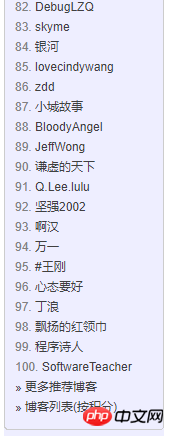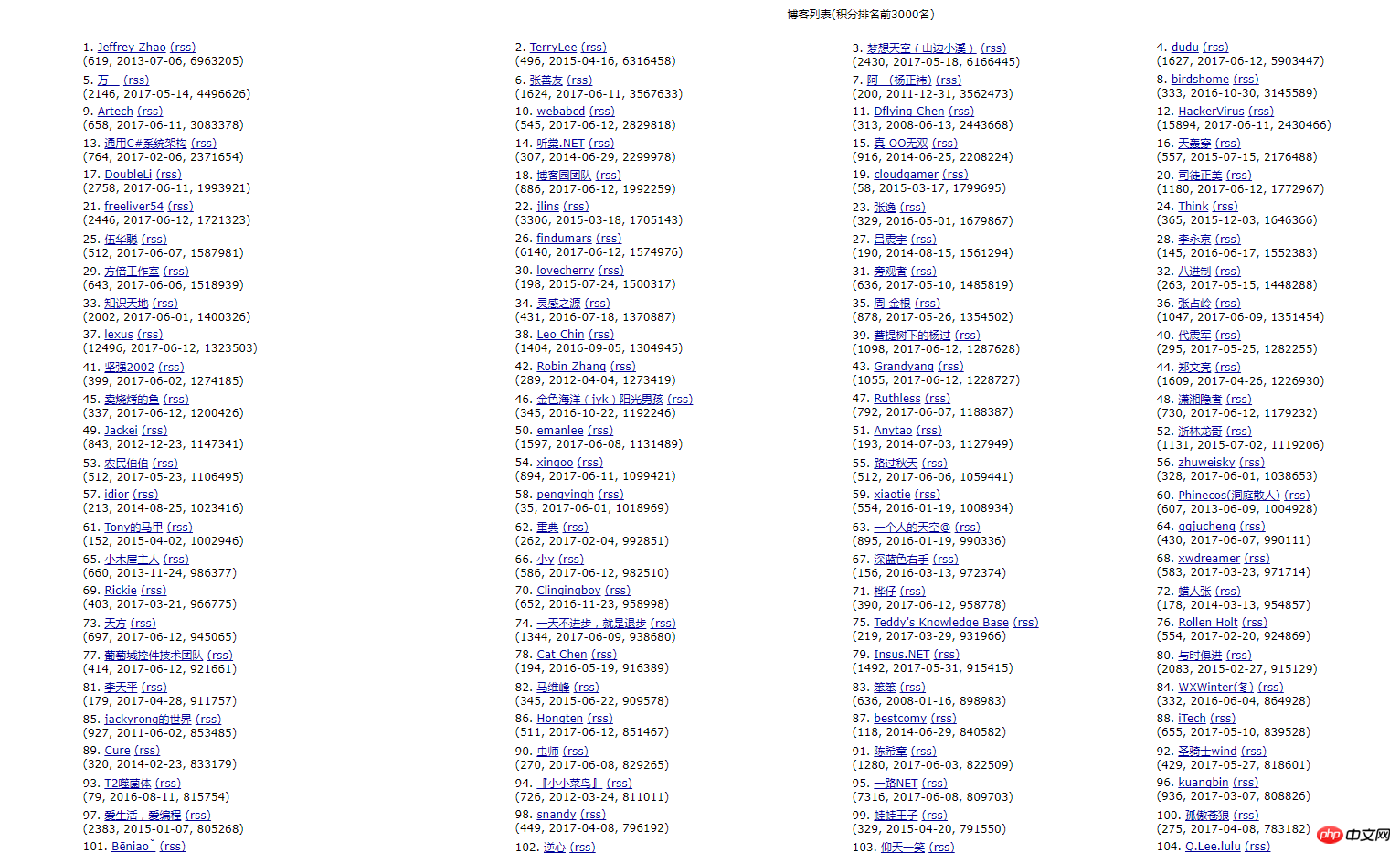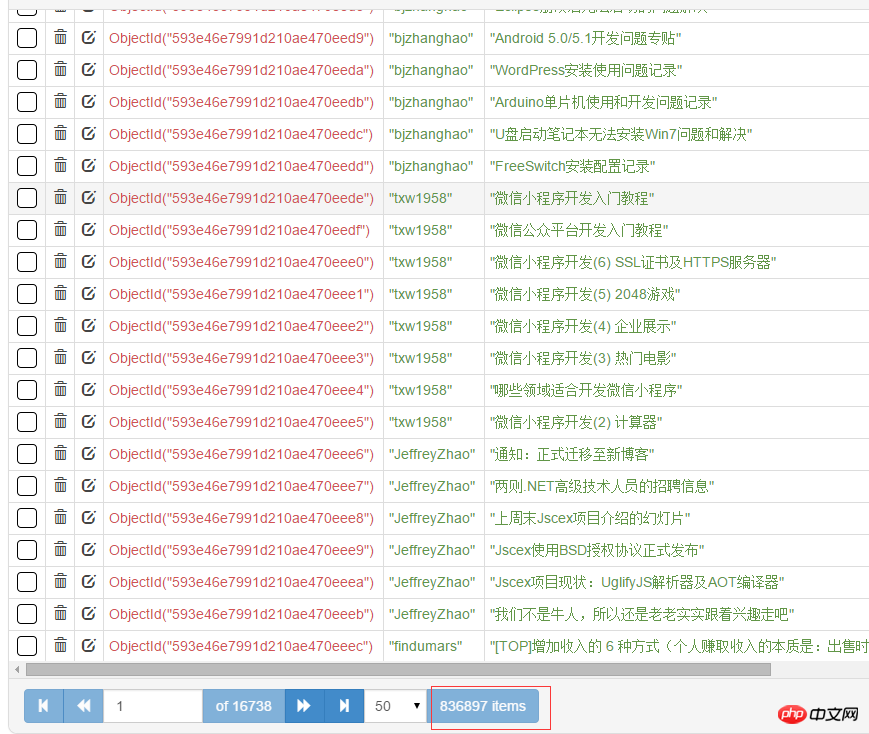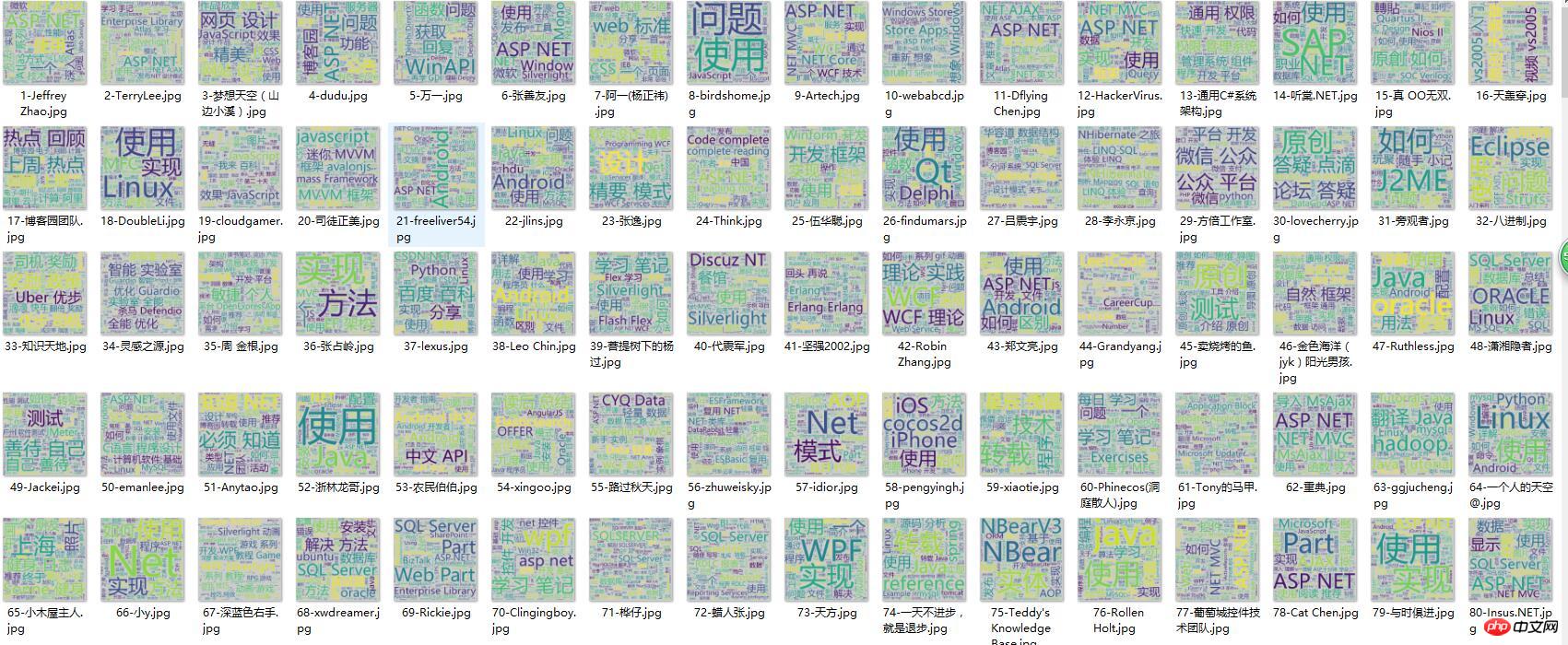

2) 페이지 구조 분석: 각 TD는 사람입니다. ㅎㅎ ccokov hand in , 두 번째 a 태그는 닉네임과 사용자 이름, 홈페이지의 블로그 주소입니다. 사용자 이름은 주소
그녀의 손 Down in\_blog 번호와 포인트는 문자열 분리 후 하나씩 획득할 수 있습니다.
3) 코드: xpath를 사용하여 홈페이지 블로그 주소를 얻은 후 요청을 보냅니다.
for i in response.xpath("//table[@width='90%']//td"):
item = CnblogsItem() "./a[1]/ item['userName'] = i.xpath(
"./a[1]/ @href").extract()[0].split('/')[-2].strip()
totalAndScore = i.xpath(
"./small[2] //text()").extract ()[0].lstrip('(').rstrip(')').split(',')
item['score'] = totalAndScore[2].strip( )
# 인쇄(상위)
# 인쇄(닉네임)
# ~ >
callback=self.parse_page)
1)页面结构:通过分析,每篇博客的a标签id中都包含“TitleUrl”,这样就可以获取到每篇博客的地址了。每页面地址,加上default.html?page=2,page跟着变动就可以了。

2)代码:置顶的文字会去除掉。
def parse_page(self, response):
# print(response.meta['nickName'])
#//a[contains(@id,'TitleUrl')]
urlArr = response.url.split('default.aspx?')
if len(urlArr) > 1:
baseUrl = urlArr[-2]
else:
baseUrl = response.url
list = response.xpath("//a[contains(@id,'TitleUrl')]")
for i in list:
item = CnblogsItem()
item['top'] = int(response.meta['item']['top'])
item['nickName'] = response.meta['item']['nickName']
item['userName'] = response.meta['item']['userName']
item['score'] = int(response.meta['item']['score'])
item['pageLink'] = response.url
item['title'] = i.xpath(
"./text()").extract()[0].replace(u'[置顶]', '').replace('[Top]', '').strip()
item['articleLink'] = i.xpath("./@href").extract()[0]
yield scrapy.Request(i.xpath("./@href").extract()[0], meta={'item': item}, callback=self.parse_content)
if len(list) > 0:
response.meta['page'] += 1
yield scrapy.Request(baseUrl + 'default.aspx?page=' + str(response.meta['page']), meta={'page': response.meta['page'], 'item': response.meta['item']}, callback=self.parse_page)
3)对于每篇博客的内容,这里没有抓取。也很简单,分析页面。继续发送请求,找到id为cnblogs_post_body的div就可以了。
def parse_content(self, response):
content = response.xpath("//div[@id='cnblogs_post_body']").extract()
item = response.meta['item']if len(content) == 0:
item['content'] = u'该文章已加密'else:
item['content'] = content[0]yield item
这一部分没什么难的。记着安装pymongo,pip install pymongo。总共有80+万篇文章。
from cnblogs.items import CnblogsItemimport pymongoclass CnblogsPipeline(object):def __init__(self): client = pymongo.MongoClient(host='127.0.0.1', port=27017) dbName = client['cnblogs'] self.table = dbName['articles'] self.table.createdef process_item(self, item, spider):if isinstance(item, CnblogsItem): self.table.insert(dict(item))return item

scrapy中的代理,很简单,自定义一个下载中间件,指定一下代理ip和端口就可以了。
def process_request(self, request, spider): request.meta['proxy'] = 'http://117.143.109.173:80'
Model类,存放的是对应的字段。
class CnblogsItem(scrapy.Item):# define the fields for your item here like:# name = scrapy.Field()# 排名top = scrapy.Field() nickName = scrapy.Field() userName = scrapy.Field()# 积分score = scrapy.Field()# 所在页码地址pageLink = scrapy.Field()# 文章标题title = scrapy.Field()# 文章链接articleLink = scrapy.Field()
# 文章内容
content = scrapy.Field()
对每个人的文章进行词云分析,存储为图片。wordcloud的使用用,可参考园内文章。
这里用了多线程,一个线程用来生成分词好的txt文本,一个线程用来生成词云图片。生成词云大概,1秒一个。

# coding=utf-8import sysimport jiebafrom wordcloud import WordCloudimport pymongoimport threadingfrom Queue import Queueimport datetimeimport os
reload(sys)
sys.setdefaultencoding('utf-8')class MyThread(threading.Thread):def __init__(self, func, args):
threading.Thread.__init__(self)
self.func = func
self.args = argsdef run(self):
apply(self.func, self.args)# 获取内容 线程def getTitle(queue, table):for j in range(1, 3001):# start = datetime.datetime.now()list = table.find({'top': j}, {'title': 1, 'top': 1, 'nickName': 1})if list.count() == 0:continuetxt = ''for i in list:
txt += str(i['title']) + '\n'name = i['nickName']
top = i['top']
txt = ' '.join(jieba.cut(txt))
queue.put((txt, name, top), 1)# print((datetime.datetime.now() - start).seconds)def getImg(queue, word):for i in range(1, 3001):# start = datetime.datetime.now()get = queue.get(1)
word.generate(get[0])
name = get[1].replace('<', '').replace('>', '').replace('/', '').replace('\\', '').replace('|', '').replace(':', '').replace('"', '').replace('*', '').replace('?', '')
word.to_file('wordcloudimgs/' + str(get[2]) + '-' + str(name).decode('utf-8') + '.jpg')print(str(get[1]).decode('utf-8') + '\t生成成功')# print((datetime.datetime.now() - start).seconds)def main():
client = pymongo.MongoClient(host='127.0.0.1', port=27017)
dbName = client['cnblogs']
table = dbName['articles']
wc = WordCloud(
font_path='msyh.ttc', background_color='#ccc', width=600, height=600)if not os.path.exists('wordcloudimgs'):
os.mkdir('wordcloudimgs')
threads = []
queue = Queue()
titleThread = MyThread(getTitle, (queue, table))
imgThread = MyThread(getImg, (queue, wc))
threads.append(imgThread)
threads.append(titleThread)for t in threads:
t.start()for t in threads:
t.join()if __name__ == "__main__":
main()
附:mongodb内存限制windows:
위 내용은 Scrapy 튜토리얼--웹사이트의 처음 N개 기사 크롤링의 상세 내용입니다. 자세한 내용은 PHP 중국어 웹사이트의 기타 관련 기사를 참조하세요!